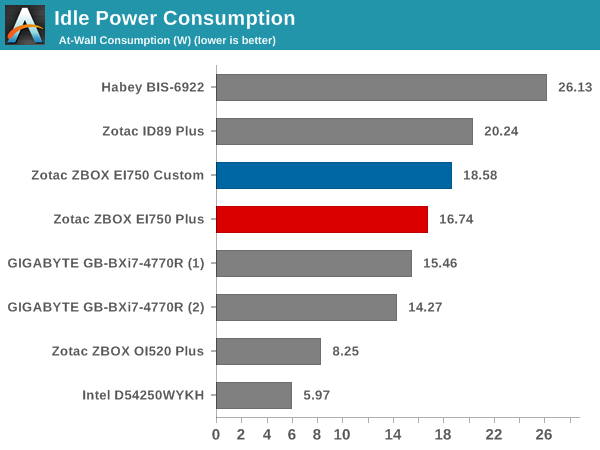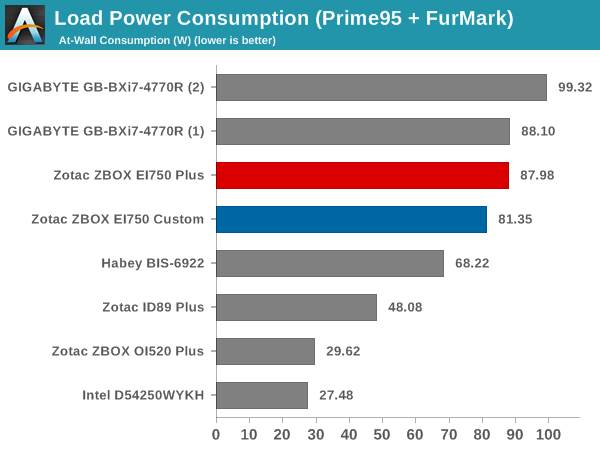Zotac ZBOX EI750 Plus: A Feature-Rich Iris Pro mini-PC
by Ganesh T S on August 25, 2014 7:00 AM ESTMiscellaneous Aspects & Final Words
The power consumption at the wall was measured with the display being driven through the DVI-HDMI port. In the graphs below, we compare the idle and load power of the ZBOX EI750 Plus with other low power PCs evaluated before. For load power consumption, we ran Furmark 1.12.0 and Prime95 v27.9 together. The addition of a SODIMM and an extra mSATA SSD in our custom configuration obviously drives up the idle power consumption numbers a bit, a penalty the user needs to pay for better performance. However, the load power consumption numbers show an inversion because the extra RAM causes heavier throttling, bringing down the load power numbers in steady state below that of the Plus configuration.


Thermal Performance
Given the active nature of the thermal solution and the size of the chassis, it would have been fair to expect the unit to be able to handle full loading of the CPU and GPU without issues. Unfortunately, just like the BRIX Pro, the unit throttles under heavy artificial loading (Prime 95 + Furmark). Unlike the BRIX Pro, the unit even throttles under pure CPU loading. The gallery below presents the different cases.
Only the pure GPU loading case doesn't throttle. This is definitely a bit disappointing, but, only from a purely engineering standpoint. The usual use-cases rarely stress the CPU and GPU to these limits. Intel is also heavily promoting the scenario design power metric for thermal design. The CPU and GPU don't do as much work as in our power virus test.
Concluding Remarks
I have been using the unit as a virtualization platform, running a Windows 7 VM and a CentOS 6.2 VM simultaneously, each of them with a dedicated wired network link. The in-built Wi-Fi is used for the host OS. The ability to put in up to 16 GB of RAM and back up the mSATA SSD with the already supplied 1 TB 2.5" HDD provides more than enough storage. With the VMs inactive, I have been using this as a compact and silent low-power software development machine with higher performance compared to other Zotac ZBOX units. Unfortunately, the flagship GPU is not utilized heavily in these scenarios. In none of these applications did we see the unit throttle due to heavy loading.
Coming to the business end of the review, we are very happy to see Zotac putting in the Iris Pro in a more feature-rich machine compared to the BRIX Pro. The unit can drive three displays simultaneously without daisy-chaining. The USB ports are more spaced out and we also have a card reader built into the unit. Most importantly, the two wired GbE ports open up various interesting applications for this powerful mini-PC. Despite the throttling aspects of the design and the fact that the BRIX Pro manages to surpass the EI750 in almost all of our benchmarks, we can recommend the Core i7 equipped ZBOX EI750 for most practical applications. It also goes without saying that end users are better off with a barebones model and choosing their own SSD and memory configurations.














34 Comments
View All Comments
MonkeyPaw - Monday, August 25, 2014 - link
Seems like the HDMI should have been a default port, but I suppose the adapter (bright yellow as it is) solves the HTPC aspect. I would think this would make a nice light duty Steambox or retrogaming machine for the living room.A small bit of advice with your device photos, use moderate incandescent ambient lighting instead of a flash, and a camera with good macro on a tripod. You'll get warmer product shots with better detail (and less reflection on the shiny black devices). Some of those product shots are a little hard to make out.
Samus - Monday, August 25, 2014 - link
Wow, $800+ and no SSD or Windows license? Holy cow. Why not just pickup a Lenovo M93p w/ i7-4765T for hundreds less with an SSD and Windows 8, or if size isn't a concern, an SFF with a discrete Radeon, for even less. Is Intel really charging these OEM's $400 for these i7-4770R's?marvdmartian - Tuesday, August 26, 2014 - link
Zotac, at least in recent years, has tended to put a pretty high premium on their hardware (IMHO). I remember them as being more of a budget-minded company, 3-5 years ago, when I used their motherboards in a few system builds. But lately, they seem to have swung to the other end of the spectrum, demanding Asus-like prices. Not sure if their hardware reliability is up to their premium price these days, though.Of course, putting that stick of ram and 1TB hard drive in there probably drove the price up a couple hundred dollars. **sigh**
2late2die - Monday, August 25, 2014 - link
"the two wired GbE ports open up various interesting applications for this powerful mini-PC"So what kinds of interesting applications would these be?
I'm not being snarky, genuinely curious. When I started reading the specs for this, the thing that stood out the most to me were the two LAN ports - how would one utilize those on a machine like this?
TerdFerguson - Monday, August 25, 2014 - link
Network router/switch/bridge? Failover switch for some fault-tolerant system?melvin121 - Monday, August 25, 2014 - link
way to expensive (and overkill) to be a router. While the footprint of this is perfect in size, you could build an ITX based system for far less and probably add a 4 port nic in the open PCIe slot.nathanddrews - Monday, August 25, 2014 - link
He states an exact scenario where this is useful in the article:"I have been using the unit as a virtualization platform, running a Windows 7 VM and a CentOS 6.2 VM simultaneously, each of them with a dedicated wired network link. The in-built Wi-Fi is used for the host OS."
Personally, I don't use VMs often, but I do like bandwidth for other reasons. The desktops/HTPCs in my house have dual gigabit ports to facilitate large file transfers and backups as quickly as possible. It's nice to have.
Samus - Monday, August 25, 2014 - link
I've never used dual-NIC's outside of Hyper-V. Failover...for what? Exactly how often do NIC's fail? This isn't an enterprise-class device. If you need failover or an additional port, these plenty of USB 3.0 ports you can add a gigabit NIC too...ggathagan - Tuesday, August 26, 2014 - link
Bonding multiple NIC's only improves the *aggregate* bandwidth, not an individual connection's bandwidth.As such, it's only of use on a NAS, where you may have multiple clients connecting and transferring data.
Each client can only transfer at the rate of a single NIC.
Chapbass - Monday, August 25, 2014 - link
I've been looking for a SFF machine with dual gigabit nics. Having the 2nd nic is great for an ESXi home lab environment. Sure, you can pile it all on one nic, but the 2nd makes it so much better, IMO.